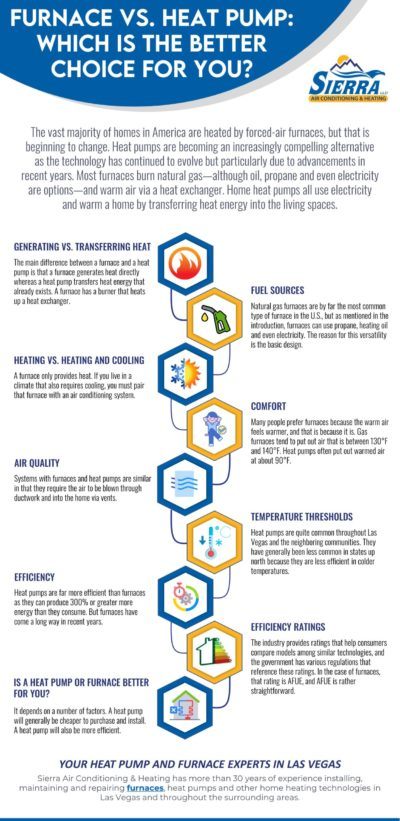The vast majority of homes in America are heated by forced-air furnaces, but that is beginning to change. Heat pumps are becoming an increasingly compelling alternative as the technology has continued to evolve but particularly due to advancements in recent years. Most furnaces burn natural gas—although oil, propane and even electricity are options—and warm air via a heat exchanger. Home heat pumps all use electricity and warm a home by transferring heat energy into the living spaces.
Generating vs. Transferring Heat
The main difference between a furnace and a heat pump is that a furnace generates heat directly whereas a heat pump transfers heat energy that already exists. A furnace has a burner that heats up a heat exchanger. That heat exchanger warms the air, and, in the case of systems that burn natural gas, oil or propane, separates the air from toxic gases that must be exhausted.
A heat pump, on the other hand, transfers heat from one space to another. Heat energy naturally wants to move into areas that have a lower temperature and thus a lower pressure. A heat pump takes advantage of this physical property. Cool liquid refrigerant is used to absorb heat energy, which converts it into a cold gas. That gas is then pressurized, which turns it into a hot gas that is then used to heat the home. The most prevalent type of heat pump is air-sourced, which means that it transfers heat energy from the ambient air. There are also ground-source or geothermal heat pumps, which transfer energy from the earth, and water-sourced, which transfer energy from a larger body of water.
Fuel Sources
Natural gas furnaces are by far the most common type of furnace in the U.S., but as mentioned in the introduction, furnaces can use propane, heating oil and even electricity. The reason for this versatility is the basic design. Furnaces require a burner. That burner can be ignited with a pilot light that consumes natural gas, propane or oil, but it can also be ignited via some form of electric ignition. Heat pump design is much more complex and thus practically all residential models on the market use electricity.
However, it is a misconception that heat pumps cannot use natural gas. There are, for instance, gas-fired absorption heat pumps and even heat pumps that operate on solar energy and geothermal hot water. Nevertheless, these are mostly reserved for commercial and industrial applications. When they are used for residential purposes, the home must be at least 4,000 square feet to justify the investment. These technologies will be made smaller with time and thus become more practical in the future.
Heating vs. Heating and Cooling
A furnace only provides heat. If you live in a climate that also requires cooling, you must pair that furnace with an air conditioning system. The process of heating a home by using refrigerant to transfer heat energy into it is the air conditioning process in reverse. Therefore, heat pumps typically have both a heating mode and a cooling mode, and that eliminates the need for two distinct units.
Comfort
Many people prefer furnaces because the warm air feels warmer, and that is because it is. Gas furnaces tend to put out air that is between 130°F and 140°F. Heat pumps often put out warmed air at about 90°F. That is well high enough to reach your desired temperature, but it can be less comfortable until you reach that point since your body temperature is 98.6°F.
Air Quality
Systems with furnaces and heat pumps are similar in that they require the air to be blown through ductwork and into the home via vents. These systems will therefore accumulate and distribute dust unlike, for instance, a hydronic heating system. Heat pumps also do not produce carbon monoxide. Neither do electric furnaces, but natural gas, propane and oil furnaces all do.
Temperature Thresholds
Heat pumps are quite common throughout Las Vegas and the neighboring communities. They have generally been less common in states up north because they are less efficient in colder temperatures. However, while heat pumps would once struggle below 40°F, they now operate well at 30°F and even 25°F depending on the unit. That is one of the innovations alluded to in the introduction that is driving the rise in popularity of air-source heat pumps even in the colder states. Note that in climates where the threshold is still a concern, a heat pump can be paired with a furnace to get the best of both worlds. This is often referred to as hybrid heating or a dual-fuel heating system.
Efficiency
Heat pumps are far more efficient than furnaces as they can produce 300% or greater more energy than they consume. But furnaces have come a long way in recent years. Practically all furnaces on the market have an efficiency of at least 80%. The EPA requires an efficiency of 90% in the U.S. South and 95% in the U.S. North for the Energy Star label. There are even furnaces that are 98.7% efficient.
Efficiency Ratings
The industry provides ratings that help consumers compare models among similar technologies, and the government has various regulations that reference these ratings. In the case of furnaces, that rating is AFUE, and AFUE is rather straightforward. A furnace that is 80% efficient—meaning that it turns 80% of the fuel it burns into heat—has an AFUE rating of 80.
Heat pumps have an HSPF rating instead. HSPF gauges efficiency over the course of a heating season. An 8.2 HSPF is currently the minimum allowed by the Department of Energy. Any unit with a 10 HSPF or above is considered a high-efficiency model, and up to 13 HSPF models are currently available. Heat pumps like air conditioners also have a SEER rating, which is a measure of their efficiency over the course of a cooling season.
Is a Heat Pump or Furnace Better for You?
It depends on a number of factors. A heat pump will generally be cheaper to purchase and install. A heat pump will also be more efficient. That does not necessarily mean that a heat pump will provide you with a lower total cost of ownership. Furnaces have a longer lifespan and are easier to maintain, and natural gas is often cheap enough that the furnace costs you less over the long run.
Your Heat Pump and Furnace Experts in Las Vegas
Sierra Air Conditioning & Plumbing has more than 30 years of experience installing, maintaining and repairing furnaces, heat pumps and other home heating technologies in Las Vegas and throughout the surrounding areas. Our company also installs, maintains and repairs air conditioners. Our team includes indoor air quality experts who can help you combat indoor air pollution via IAQ testing, mechanical ventilation, air purification, dehumidifiers and humidifiers, and we have certified plumbers who can install, service and repair water heaters, water filtration systems and water softening systems.
Call us today or contact us online to learn more about these services or to schedule an appointment!




